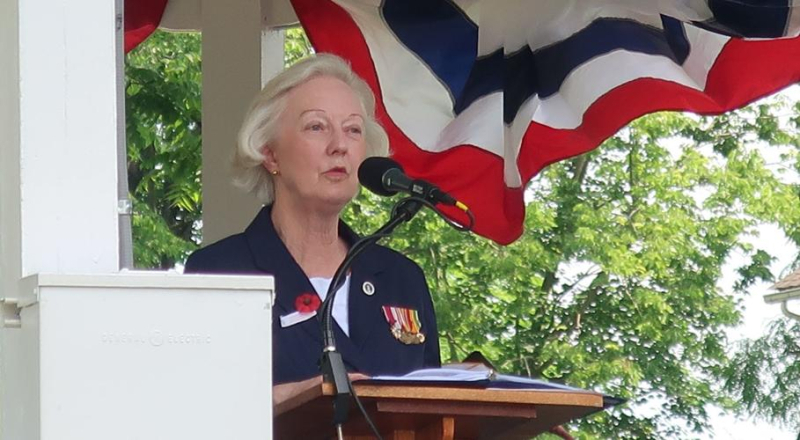
BERRYVILLE — Women have served a vital role in every conflict and war shaping the United States since before the country was founded.
At the annual Memorial Day service in Berryville’s Rose Hill Park held Sunday and organized by American Legion Post 41, women were recognized for the role they’ve played in the nation’s military.
“Generations of uniformed men and women have come and gone,” Post Commander Jon Joyce told the crowd. “Today we are here to honor our brothers and sisters in arms who did not come home.”
Joyce said the post wanted to focus on women in the military as the theme for this year’s service.
“How appropriate, since 2019 is ‘the year of the woman,’” Joyce said, referring to the number of women recently elected to serve in Congress.
“Women have supported the military since the [Revolutionary War],” Post Vice Commander Will Watson said before he introduced keynote speaker Col. Nancy Braswell, U.S. Air Force retired.
Braswell, a Frederick County resident who retired from active duty in 1989 and moved to the area in 1991, joined the Air Force just after graduating from the State University of New York at Buffalo in 1969. She served in Vietnam and later at posts in Germany and Washington, D.C.
During her speech, she gave a timeline of women in the U.S. military.
At the time of the American Revolution, many women followed their husbands to war out of necessity, Braswell said. They served as nurses, cooks and laundresses in military camps, though some women disguised their identities so they could fight. Deborah Sampson, for instance, served for more than a year in Gen. George Washington’s army disguised as a man, from 1782 to 1783. She later became one of the first women in U.S. history to receive a military pension, after her gender was discovered.
In 1866, 22-year-old former slave Cathy Williams, who had been forced to serve Confederate soldiers as a seamstress and cook, became the first black woman to serve in the U.S. Army by adopting the pseudonym William Cathy, Braswell said. She served for three years before being discharged because a surgeon discovered her gender.
In World War I, 36,000 women served in the Army Nurse Corps and 350 of them died overseas, according to Braswell. Among those who served was local resident Nanny Gray McDonald Eustaphieve, who was an Army nurse in France during WWI. She died in 1955 and is buried in Green Hill Cemetery in Berryville.
In World War II, large numbers of women served in auxiliary roles to “free up the men to fight,” Braswell said. Women worked as mechanics, engineers, clerks, nurses, truck drivers and intelligence officers. More than 80 women were imprisoned in Japanese prisoner of war camps before 1945.
Amid large-scale de-escalation in 1947, the military realized it was going to have recruitment challenges.
“The armed forces viewed women as an important personnel source,” Braswell said.
In 1948, Congress passed the Women’s Armed Services Integration Act, granting women permanent status in the military subject to military authority and regulations and entitled to veterans benefits, but it wasn’t until 1976 that women were admitted to military service academies.
In Vietnam, concern that “public controversy” would impede the war effort, women were kept out of combat roles, Braswell said. But in 1991, Congress authorized women to fly on combat missions and, in 1993, serve on combat ships.
“Women continued to play more active roles in [wars],” Braswell said.
In 2016, Congress opened up all combat roles to women. By then, a number of women had risen to some of the highest ranks of military leadership and been awarded some of the military’s most distinguished honors.
Today, almost 210,000 women serve active duty in the armed forces, Braswell said. “Not as women, but as soldiers, sailors, Marines and Coast Guardsmen.”
— Contact Onofrio Castiglia at ocastiglia@winchesterstar.com
